 Marine Surveyor 33463 – How to Ensure a Comprehensive Inspection of Steering Systems?
Marine Surveyor 33463 – How to Ensure a Comprehensive Inspection of Steering Systems?
When it comes to ensuring the safety and reliability of a vessel, one of the most critical components that must be thoroughly inspected is the steering system. As a Marine Surveyor 33463, it is your responsibility to conduct a comprehensive examination of the steering mechanism to identify any potential issues or defects that could compromise the vessel’s seaworthiness.
At Suncoast Marine Surveying, we understand the importance of a thorough inspection of a vessel’s steering system. Our team of experienced marine surveyors are well-versed in the intricacies of inspecting steering systems and can help ensure that your vessel is in compliance with all relevant regulations and safety standards.
Here are some key steps that Marine Surveyor 33463 should take to ensure a comprehensive inspection of steering systems:
1. Review Documentation: Before conducting the physical inspection of the steering system, it is important to review all relevant documentation related to the vessel’s steering mechanism. This may include maintenance records, installation manuals, and any previous survey reports.
2. Visual Inspection: Start by visually inspecting the steering system for any signs of corrosion, wear, or damage. Look for leaking hydraulic fluid, loose connections, or missing parts that could indicate underlying issues.
3. Check for Proper Operation: Test the steering system to ensure that it operates smoothly and without any excessive play or resistance. Verify that the wheel turns easily and that there are no unusual noises or vibrations when steering.
4. Inspect Components: Take a closer look at all the components of the steering system, including the rudder stock, quadrant, tiller arm, cables, hydraulic pumps, and cylinders. Check for signs of wear, corrosion, or fatigue that could lead to failure.
5. Evaluate Steering Fluid: If the vessel has a hydraulic steering system, check the condition and level of the steering fluid. Look for any leaks or contamination that could affect the performance of the system.
6. Test Emergency Steering: In addition to testing the primary steering system, make sure to test the emergency steering mechanism as well. This may involve manually operating the backup tiller or verifying the functionality of a secondary hydraulic pump.
7. Inspect Mounting Hardware: Examine the mounting hardware and brackets that secure the steering components in place. Ensure that they are tight and properly installed to prevent any movement or failure during operation.
8. Review Manufacturer Recommendations: Refer to the manufacturer’s guidelines for maintenance and inspection of the specific steering system installed on the vessel. Follow their recommendations for servicing intervals and replacement parts.
9. Verify Compliance: Confirm that the vessel’s steering system meets all relevant regulations and safety standards, such as ABYC (American Boat and Yacht Council) guidelines for steering systems.
10. Document Findings: Keep detailed notes and photographs of any issues or deficiencies identified during the inspection of the steering system. Provide a written report to the vessel owner with recommendations for repairs or replacements.
By following these steps, Marine Surveyor 33463 can ensure a comprehensive inspection of a vessel’s steering system and help mitigate any potential risks or liabilities associated with steering failure. Suncoast Marine Surveying is committed to providing thorough and reliable marine surveying services to ensure the safety and seaworthiness of all types of vessels. Contact us today for more information on our services or to schedule an inspection of your vessel’s steering system. With Suncoast Marine Surveying by your side, you can navigate the seas with confidence knowing that your vessel is in top condition.r


